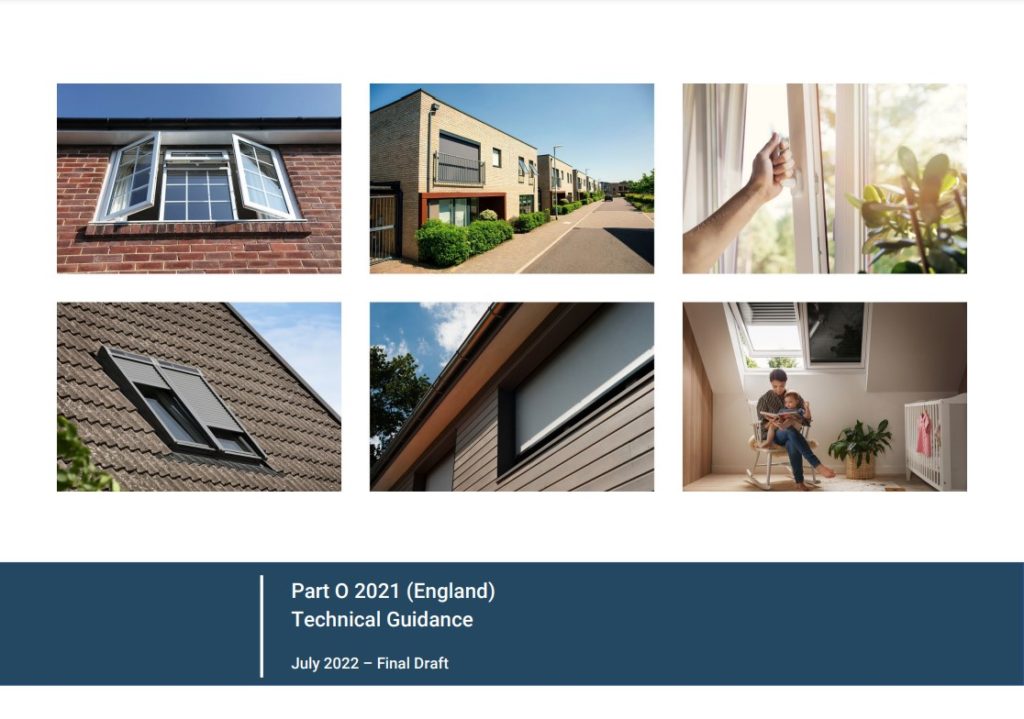Part O – the Inkling appraisal – Part 3
Part O of the Building Regulations (England) came into force in June 2022. Susie Diamond shares her thoughts on the subject with a 3rd instalment.
A lot of my concerns regarding the complexity of the Approved Document including the ‘simplified method’ and ensuring that all the fiddly requirements are met pre-planning to avoid costly redesign still stand (see previous 2 blogs – links below), but there is now a significant amount of supportive advice published which I will cover in this blog.
Blog #1: https://inklingllp.com/2022/02/15/part-o-the-inkling-appraisal/
Blog #2: https://inklingllp.com/2022/03/29/part-o-part-2/
New Guidance available
FHH Guide – Julie Godefroy and I have written detailed guidance on Part O (England) for the Future Homes Hub (FHH). This is now published and free to download from the FHH website here: https://irp.cdn-website.com/bdbb2d99/files/uploaded/Part%20O%20guidance%20-%20technical.pdf
This guidance is aimed at housebuilders, but will hopefully be useful for anyone trying to get their head around how to achieve and demonstrate compliance. It includes advice on how to approach all the requirements including those on noise, safety and security, a detailed worked example following both the simplified method route and using dynamic thermal modelling and 4 case studies. It has been approved by DLUHC and factors in additional updated from the FAQs – see below.
The FHH also aim to publish a simpler ‘Part O – Where to start’ Guide and provide a spreadsheet to assist with assessments following the simplified method.

FAQs – DLUHC have published a series of FAQs with responses which gives extra help on some of the commonly raised question: https://www.gov.uk/government/publications/overheating-approved-document-o/approved-document-o-overheating-frequently-asked-questions
Acoustic Guidance – The Institute of Acoustics and Association of Noise Consultants (ANC) have published a very helpful draft guidance document on demonstrating compliance with the noise requirements of Approved Document O. https://www.association-of-noise-consultants.co.uk/demonstrating-compliance-with-the-noise-requirements-of-approved-document-o/
Recommended reading for any sites in urban areas close to transport routes.
Discussion – I recently participated (21/7/2022) in a CIBSE West Midlands on-line panel discussion on the implementation of Part O which you can watch the recording of here: https://www.youtube.com/watch?v=ZbIzqp8rUr0
If all these sources do not cover the questions you have then best advice is to contact your building control officer who should be able to give more specific advice on a scheme-by-scheme basis.
If you need are looking for experienced modellers who can provide compliance modelling for Part O then look no further! Inkling will be happy to discuss your requirement and provide a fee proposal.
We are considering offering an Inkling webinar on Part O compliance at some point after the summer.
Contact us if you would be interested in attending this webinar or would like a quote.
Part O in Scotland and Wales
It is worth noting that the version of Part O that I have examined and blogged about here is the one that is in force in England.
Wales has adopted a similar but slightly different Approved Document: https://gov.wales/building-regulations-guidance-part-o-overheating
Scotland has also introduced regulation aimed at reducing overheating risk in homes in section 3.28 of their ‘Technical Handbook – Domestic’ that comes into force from December this year: https://drive.google.com/file/d/1Zz2akStdTb1uEc_db9KH72iySvmDC5X0/view?usp=sharing
Both the Welsh and Scottish approaches use a simplified and a dynamic modelling route, but there are some interesting differences:
- The simplified method sets glazing and ventilation targets that are not based on location, but do allow shading options to increase the allowable glazing proportion
- Neither include criteria on night time noise, so presumably leave it to planning to determine whether opening windows can be relied upon for overheating mitigation
- Both allow dynamic thermal modelling following TM59 and exclude the use of internal blinds
- The requirements on guarding/sill height appear to apply in both sets of regulation although they are described differently
- The requirements on a max reach of 650mm are present in the Welsh regulations, but I could not find it in the Scottish regulation, although it looks like dynamic models are required to assume restrictors on bedrooms windows (max 10° opening angle) to ‘reflect safety and security concerns’.
The wording in the Welsh version seems clearer than the English version. For example:


I have not read the Wales and Scotland regulations in detail, or tried to apply them in practice yet, and I am not sure when I’ll get the chance to do so.
If you have done any analysis comparing the three, or know what the situation on this is in Northern Ireland, I’d be keen to hear from you.
This is the third in our blog series on Part O:
 Posted by Susie Diamond
Posted by Susie Diamond- Posted in Overheating, Publications, Research, Susie Diamond
 Jul, 25, 2022
Jul, 25, 2022 Comments Off on Part O – the Inkling appraisal – Part 3
Comments Off on Part O – the Inkling appraisal – Part 3

 Susie: 07972 263 676
Susie: 07972 263 676
 Join Us On In.com
Join Us On In.com
